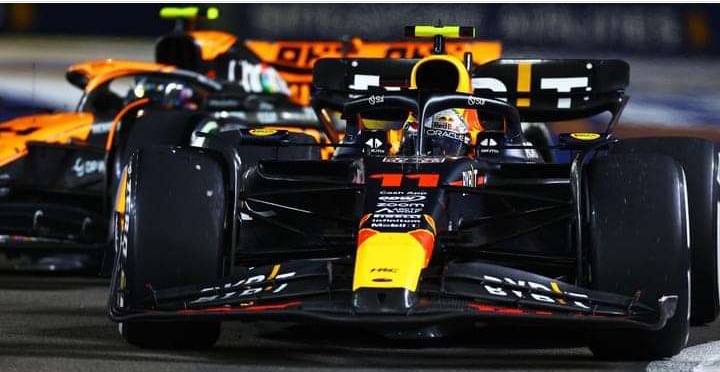How Red Bull so drastically lost its way, according to Gary Anderson.

The streak of victories for Red Bull in Formula 1 is over.
Everyone eventually falls out of favor, but the Singapore Grand Prix’s demise was so abrupt that it caught everyone off guard. Red Bull was probably even more shocked than the rest of us by it.
Consequently, why did it occur, how did a potential polesitter and race winner get disqualified in Q2, and most importantly, why was the radio talk about Red Bull’s issues so overt?
Max Verstappen has been harping on the gearchanges that he has mentioned so frequently for the majority of the season.
The electronics take control after you pull a paddle.
It should shift up or down smoothly, like swallowing an oyster, with these zero-torque-loss gear changes.
This effectively functions as a form of traction control because it enables the driver to use an upchange to lessen wheelspin.
It gives the rear a sharp snap as the new gear engages, though, if it isn’t smooth.
When everything is at its maximum adhesion during braking, the same thing occurs during the downshift.
Although it is a tool in the driver’s toolbox, Verstappen exhibits a strong sensitivity to this issue.
I can see why he gets a little giddy when it malfunctions when you are at the limit and using this feature as a basic traction control mid-corner because all it takes is one snap of oversteer to end the lap.
Did Red Bull suffer as a result of the F1 flexing its clampdown?
Gone are the days when shifting gears required letting go of the steering wheel and using a lever attached to the gearbox by a rigid rod.
I recall that one of Ayrton Senna’s tricks was to shift down directly from sixth or seventh gear to second because he disliked the snapping under braking produced by shifting through the intermediate gears.
If that were required of drivers today, can you imagine the complaints they might have?
So, that was one issue Red Bull faced.
The upgrades will now be discussed.
Red Bull brought a replica of the rear wing flap detail that McLaren invented at Zandvoort (kudos to the McLaren team; it’s not often that can be said).
The rear wing flap-to-endplate detail in this area (highlighted in red) is extremely inefficient because three different air pressures—low pressure underneath the wing, high pressure on top of the wing, and more or less ambient pressure on the outside of the endplate—meet up and create a vortex.
The car is pulling this vortex along, so removing the point where the ambient pressure outside the endplate and the low pressure underneath meet improves overall efficiency with only a slight loss of rear wing downforce.
Red Bull’s floor had also been changed. As usual, only the outer edge detail allows us to see what has changed underneath.
It’s challenging for me to see the overall changes further along the car because the images I have to work with are so close to the adjustments they made on the forward edge of the floor. However, the initial double vane (green ellipse) resembles it a lot.
I guess the reasoning behind that is that if one exit vane is effective, two should be more effective (red arrows).
The new construction appears to have lost some of its curved shape, and in order to make room for a second one, it appears that the slotted flap’s outer floor edge that extends further back has become shorter.
The airflow now has a more difficult path to travel.
As the weekend wore on, Red Bull began to have doubts in this area. Red Bull back-to-back both floors, but at a circuit where the circumstances are altering at a rapid pace, it is very challenging to derive any sort of meaningful conclusion.
It ultimately decided to employ the previous iteration.
When we compare Carlos Sainz’s pace from Free Practice 1 to Qualifying 3 to that of Max Verstappen and Sergio Perez, the results are as follows:.
According to a quick analysis of those figures, Red Bull didn’t start the weekend as we’ve come to expect and slipped further and further behind Sainz, who won the pole position for Ferrari. Sainz didn’t have a bad FP1, as he was second fastest to teammate Charles Leclerc, and other than Q1, which is just about finishing in the top 15, he was fastest in every session.
In Q1, he exercised good judgment and avoided taking any extreme actions that might have caused him to run into the wall or become involved in someone else’s accident. In order to proceed, all that needed to be done was just enough. In Q2 and Q3, more was required.
How Sainz took Leclerc’s place as Ferrari’s leader.
Sainz improved by 1 point 989 seconds or 2 point 129 percent from FP1 to Q2, Verstappen by 1 point 303 seconds or 1 point 339 percent, and Perez in Q1 by 1 point 626 seconds or 1 point 831%, all taking into account the potential track evolution between Q2 and Q3. That indicates Red Bull was not making the advancements you might anticipate on a typical weekend.
What might have happened if it had taken a different course is still up in the air. Red Bull’s inability to keep up with the track evolution was the last thing I would have anticipated given the Singapore track surface, track temperature, humidity, and transition from extremely hot FP1 and FP3 sessions to slightly cooler FP2 and qualifying sessions.
If I had to guess as to the root of Red Bull’s issues, I would say that it arrived in Singapore with the underfloor modifications mentioned above, and when it faltered in FP1, it experienced a mild panic and switched to an older floor specification, which didn’t solve the issues. All of this decreased the amount of time it needed to follow the track’s development while making the most of the resources it arrived with.
Furthermore, the significant adjustments made after Free Practice 3 didn’t work out and rendered the car “undriveable” in qualifying, according to Verstappen.
Red Bull claimed that the issue wasn’t brought on by the new floor, but I doubt that I would have anticipated a different statement from the company. Every team has had trouble simulating underfloor performance with these ground effect underfloors. We all believed that Red Bull was impervious to issues of that nature, but, sorry Mr. Adrian Newey, perhaps not.
We’ll check its specifications and performance at Suzuka. If necessary, I would test the new version in FP2 after completing the old one, which has been so successful in recent races. Stick with what you know if you discover that you lack the time.
If this was the result of the FIA tightening up the reins on flexibility enforcement and enacting technical directive 18 as a blanket standard for any aspect of the car it felt went beyond acceptable limits, I would be very surprised (see what I did there? But I’ve been surprised before, so we’ll need more information before we can be certain.
Red Bull likely didn’t start the weekend with the proper set-up strategy, the floor upgrade caused some confusion, and then there wasn’t enough time to fix things, which is what caused Red Bull’s performance to decline at the Singapore GP. Despite the fact that it’s uncommon for teams to be off the mark at the start of weekends given the extensive amount of simulation work completed, this is very simple to do and can put you behind the pace.
At Suzuka, a track that is a significant test of your car’s aerodynamic performance, in a few days, we’ll see if it was able to correct that.






